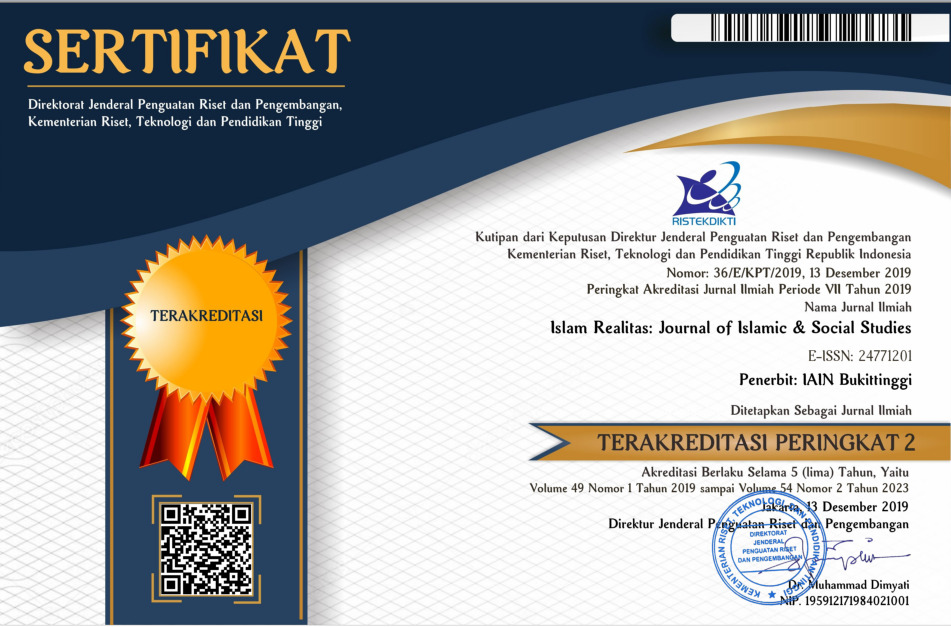Tablighi Jamaat, An Islamic Revivalist Movement and Radicalism Issues
Downloads
This article discusses Tablighi Jamaat as Islamic transnational movement that emerged in the early 20th century and attracted a great attention post nine eleven in America. One of the interesting that invite debate among scholars is that Tablighi Jamaat is a part of radicalist movements or terrorist groups or only an Islamic missionary movement. Those debates are related to the existence of Tablighi Jamaat around the world. Moreover, it can be said that every country in the world have settled by Tablighi Jamaat. American Foreign Council report shows that tablighist is estimated 50 to 80 million people. The numbers have invited suspicion of policy maker from many countries, particularly on radicalism issues. Discussion on this article based on basic questions on who are Tablighists, their aims and their activities. However, the main purpose of this article to show how scholars argue on the existence of Tablighi and possibility on Tablighi Jamaat involvement on radicalism actions. This study based on library research and direct observation on Tablighi in Central Java dan East Java.
Artikel ini mendiskusikan Tablighi Jamaat sebagai gerakan Islam transnasional yang muncul pada awal abad ke-20 dan menyita perhatian setelah peristiwa nine eleven (9/11) di Amerikan. Salah satu hal yang menarik dan mengundang perdebatan di kalangan ilmuwan adalah apakah Tablighi Jamaat merupakan bagian dari gerakan atau kelompok radikalis atau bahkan teroris, atau sebatas gerakan keagamaan belaka. Perdebatan-perdebatan tersebut terkait dengan keberadaan Tablighi Jamaat di berbagai Negara di seluruh dunia. Bahkan, dapat dikatakan bahwa setiap Negara telah terjamah oleh keberadaan Tablighi Jamaat. Dewan Amerika Luar Negeri menunjukkan bahwa diperkirakan ada 50 hingga 80 juta tablighis di seluruh dunia. Jumlah tersebut tentu mengundang kekhawatiran para pengambil kebijakan di berbagai negera, khususnya terkait dengan isu radikalisme. Diskusi dalam artikel ini berdasarkan pada pertanyaan-pertanyaan mendasar siapa sebenarnya Tablighi Jamaat, tujuan dan aktivitas mereka. Namun, tujuan utama dari artikel ini adalah untuk menunjukkan argument-argumen para ilmuwan mengenai keberadaan Tablighi Jamaat dan kemungkinan Tablighi Jamaat terlibat dalam aksi-aksi radikalisme. Kajian ini didasarkan pada kajian kepustakaan dan obersevasi langsung penulis, khusunya di wilayah Jawa Tengah dan Jawa TimurBooks
Ali, Jan Ashik, Islamic Revivalism: A Study of the Tablighi Jamaat in Sydney (Sydney: University of New South Wales, 2006)
Al-Rasyid, Mulwi Ahmad Harun, Meluruskan Kesalahpahaman Terhadap Jaulah (Jamaah Tabligh) (Temboro, Magetan: Pustaka Haramain, 2004).
Assirbuny, Abdurrahman Ahmad, Kupas Tuntas Jamaah Tabligh Jilid 1 (Cirebon: Pustaka Nabawi, 2010).
———, Kupas Tuntas Jamaah Tabligh Jilid 2 (Cirebon: Pustaka Nabawi, 2010).
———, Kupas Tuntas Jamaah Tabligh Jilid 3 (Cirebon: Pustaka Nabawi, 2010).
Hedges, Joshua W, Tablighi Jamaat: The Premier Latent Network (Washington: The Fund for Peace, April 2008), p. 1–12. <https://www.files.ethz.ch/isn/93813/200804%20Tablighi%20Jamaat.pdf>. {accessed 30 April 2019}.
Jary, David, and Julia Jary, Collins: Dictionary of Sociology (Glasgow: Harper Collins Manufacturing, 1991)
Lubis, Abdurrahman, Tabligh ‘Genggam’ Umat Lima Benua (Jakarta: Pustaka Billah, 2009).
Masud, Muhammad Khalid, ed., 'Travellers in Faith: Studies of the TablÄ«ghÄ« JamÄÊ»at as a Transnational Islamic Movement for Faith Renewal', in Social, Economic, and Political Studies of the Middle East and Asia, v. 69 (Boston: Brill, 2000).
Noor, Farish A., Islam on the Move: The Tablighi Jama’at in Southeast Asia (Amsterdam: Amsterdam University Press, 2012).
Rana, Muhammad Amir, Tablighi Jamaat: Discourse and Challenges (Pakistan: Pak Institute for Peace Studies, 2009)
Said, M Ridwan Qoyyum, Membongkar Kedok Jaulah (Jamaah Tabligh (Kediri: Mitra Gayatra, 2004)
Journals
Ali, Jan A, ‘Islamic Revivalism: The Case of the Tablighi Jamaat, Journal of Muslim Minority Affairs, 23.1 (2003), 1-11. <https://doi.org/10.1080/13602000305935>
———, ‘Tablighi Jamaat: A Transnational Movement of Islamic Faith Regeneration’, European Journal of Economic and Political Studies (EJEPS), 3.Special Issue (SI) (2010), 103–31.
Ameer, Ali, ‘Tabligh Jama’at and Hizbul Tahrir: Divergent Paths to Convergent Goals, Education to Counter Extremism’, Dialogue & Alliance, 20.2 (2006), 51–66.
Aziz, Abdul, ‘The Jamaah Tabligh Movement in Indonesia: Peaceful Fundamentalist’, Studia Islamika, 11.3 (2004), 475 <https://doi.org/10.15408/sdi.v11i3.596>.
Balci, Bayram, ‘The Rise of the Jama’at al Tabligh in Kyrgyzstan: The Revival of Islamic Ties between the Indian Subcontinent and Central Asia?’, Central Asian Survey, 31.1 (2012), 61–76. <https://doi.org/10.1080/02634937.2012.647843>
Balcı, Bayram, ‘Reviving Central Asia’s Religious Ties with the Indian Subcontinent? The Jamaat al Tabligh’, Religion, State and Society, 43.1 (2015), 20–34. <https://doi.org/10.1080/09637494.2015.1020140>
Burki, Shireen Khan, ‘The Tablighi Jama’at: Proselytizing Missionaries or Trojan Horse?’, Journal of Applied Security Research, 8.1 (2013), 98–117. <https://doi.org/10.1080/19361610.2013.738407>
Bustamam-Ahmad, Kamaruzzaman, ‘The History of Jama‘ah Tabligh in Southeast Asia: The Role of Islamic Sufism in Islamic Revival’, Al-Jami’ah: Journal of Islamic Studies, 46.2 (2008), 353–400. <https://doi.org/10.14421/ajis.2008.462.353-400>
Gaborieau, Marc, ‘What Is Left of Sufism in Tablîghî Jamâ‘At?’, Archives de Sciences Sociales Des Religions, 135, 2006, 53–72. <https://doi.org/10.4000/assr.3731>
Janson, Marloes, ‘Renegotiating Gender: Changing Moral Practice in the Tablighi Jama’at in The Gambia’, Journal for Islamic Studies; Rondebosch, 28 (2008), 9-36.
Lone, Rameez Ahmad, ‘Tablighi Jamaat : Ideological Structure’, International Journal of Research in Social Sciences, 8.1 (2018), 1001–11.
Metcalf, Barbara D., ‘Islam and Women: The Case of the Tablighi Jama`at’, Stanford Humanities Review, 5.1 (1995), 51–59.
———, ‘Living Hadith in the Tablighi Jama’at’, The Journal of Asian Studies; Ann Arbor, 52.3 (1993) 584-608.
———, ‘Travelers’ Tales in the Tablighi Jamaat’, The Annals of the American Academy of Political and Social Science, 588.1 (2003), 136–48. <https://doi.org/10.1177/0002716203588001009>.
Nasritdinov, Emil, ‘Spiritual Nomadism and Central Asian Tablighi Travelers’, Ab Imperio, 2. 1 (2012), 43. <https://doi.org/10.1353/imp.2012.0062>
Putra, Zulkhan Indra, ‘The Tablighi Jamaat Movement Its Ideological Concept and Organizational Structure’, Afkaruna: Indonesian Interdisciplinary Journal of Islamic Studies, 9.1 (2013), 1-12.
Siddiqi, Bulbul, ‘Reconfiguring the Gender Relation: The Case of the Tablighi Jamaat in Bangladesh’, Culture and Religion, 13.2 (2012), 177–92. <https://doi.org/10.1080/14755610.2012.674956>
Wong, Diana, and Peggy Levitt, ‘Travelling Faiths and Migrant Religions: The Case of Circulating Models of Da’wa among the Tablighi Jamaat and Foguangshan in Malaysia’, Global Networks, 14.3 (2014), 348–62. <https://doi.org/10.1111/glob.12063>
Online references
Alexiev, Alex, ‘Tablighi Jamaat: Jihad’s Stealthy Legions’, in Middle East Quarterly, 2005. <https://dev.meforum.org/686/tablighi-jamaat-jihads-stealthy-legions>. {accessed 7 December 2019}
Ali, As’ad Said, ‘Jamaah Tabligh’, in NU Online 2011. <https://www.nu.or.id/post/read/32537/jamaah-tabligh>. {ccessed 7 April 2019)
American Foreign Policy Council, ‘Tablighi Jamaat’, in Almanac on Islamism. <http://almanac.afpc.org/tablighi-jamaat>. {accessed 24 April 2019}
American Foreign Policy Council, 'Tablighi Jamaat' in almanac.afpc.org 2010. <http://almanac.afpc.org/sites/almanac.afpc.org/files/Tablighi%20Jama'at.pdf>. {accessed 7 April 2019}
Choudhury, Salah Uddin Shoaib, ‘Tablighi Jamaat: Wolf in Sheep’s Skin’, in Blitz, 2018. <https://www.weeklyblitz.net/world/tablighi-jamaat-wolf-in-sheeps-skin/>. {accessed 3 May 2019}
Gaborieau, Marc, ‘Transnational Islamic Movements: Tablighi Jama’at in Politics?’, ISIM Newsletter, 1999, <https://www.researchgate.net/publication/277096388_Transnational_Islamic_Movements_Tablighi_Jama'at_in_Politics/citation/download> {accessed 4 October 2019}
Janson, Marloes, ‘The Prophet’s Path Tablighi Jamaat in The Gambia’, in Open Access Leiden University 17, 2006. <https://openaccess.leidenuniv.nl/handle/1887/17063>. {accessed 7 April 2019}
Metcalf, Barbara D., ‘Traditionalist Islamic Activism: Deoband, Tablighis, and Talibs’ in ISIM 2002. <https://openaccess.leidenuniv.nl/bitstream/handle/1887/10068/?sequence=1> {accessed 7 April 2019}
Noor, Farish A., 'The Spread of the Tablighi Jama’at across Western, Central and Eastern Java and the Role of Indian Muslim Diaspora', in RSIS Working Paper, No. 175) Nanyang Technological University, 2009<https://dr.ntu.edu.sg/handle/10220/6100>. {accessed 7 December 2019}
Zahid, Farhan, ‘Tablighi Jamaat and its Links with Islamist Terrorism' in Centre Français de Recherche sur le Renseignement. <https://cf2r.org/foreign/tablighi-jamaat-and-its-links-with-islamist-terrorism-2/>. {accessed 7 April 2019}
Authors who publish with this journal agree to the following terms:
- Authors retain copyright and grant the journal right of first publication with the work simultaneously licensed under a Creative Commons Attribution License that allows others to share the work with an acknowledgment of the work's authorship and initial publication in this journal.
- Authors are able to enter into separate, additional contractual arrangements for the non-exclusive distribution of the journal's published version of the work (e.g., post it to an institutional repository or publish it in a book), with an acknowledgment of its initial publication in this journal.
- Authors are permitted and encouraged to post their work online (e.g., in institutional repositories or on their website) prior to and during the submission process, as it can lead to productive exchanges, as well as earlier and greater citation of published work (See The Effect of Open Access).









